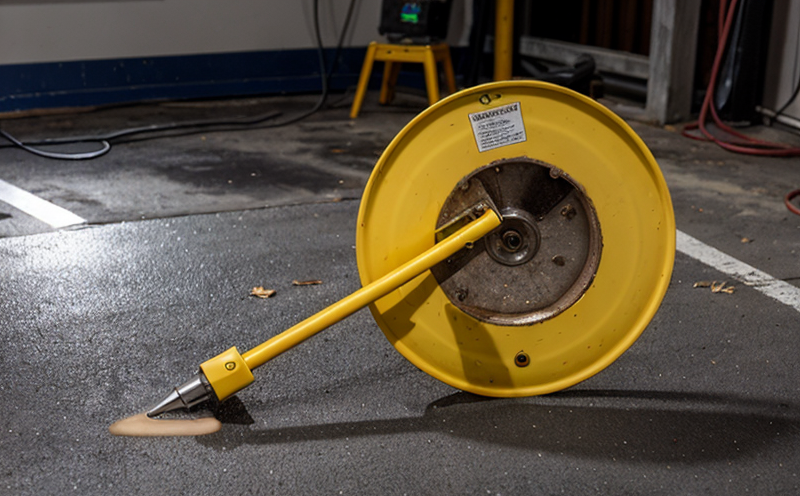ASTM E376 Eddy Current Thickness Testing of Metallic Coatings
The ASTM E376 standard specifies a procedure for eddy current thickness measurement of metallic coatings on electrically conductive substrates. This non-destructive evaluation (NDE) method is widely used in industries such as aerospace, automotive, and manufacturing to ensure the integrity and quality of coatings applied to various components.
ASTM E376 relies on eddy currents generated by an alternating electromagnetic field. These currents interact with the conductive coating, creating a measurable impedance change that is directly related to the thickness of the coating. This technique allows for precise measurement without altering or damaging the substrate or coating in any way.
One of the primary advantages of this method is its ability to provide real-time data on coating thickness during manufacturing processes. This ensures consistent quality and helps prevent defective parts from reaching production lines. Additionally, ASTM E376 can be used to monitor changes over time, which is crucial for long-term maintenance and reliability.
The process typically involves placing a probe with an integrated coil onto the surface of the coated component. The probe generates an electromagnetic field that penetrates the coating layer and interacts with the substrate. By analyzing the resulting impedance changes, technicians can accurately determine the thickness of the coating. This approach is especially useful for thin coatings (typically less than 10 μm), where other methods may not be as precise.
Preparation of specimens before testing according to ASTM E376 involves cleaning the surface thoroughly to remove any contaminants that could interfere with the measurement. Substrates should also be free from burrs, sharp edges, and other irregularities that might affect the accuracy of the results. Once prepared, the specimens are ready for eddy current thickness testing.
Instrumentation plays a critical role in ASTM E376 compliance testing. Advanced eddy current instruments equipped with software capable of interpreting impedance data are essential. These tools provide automated reporting features and graphical representations that enhance interpretability and ease of use. Calibration of the instrument is also important to ensure accurate measurements.
Reporting under ASTM E376 includes detailed documentation of the test parameters, including frequency settings, probe geometry, and any adjustments made during testing. Results are typically presented as average coating thickness values along with standard deviations where appropriate. Additional information such as pass/fail criteria based on specified tolerances should also be included in the report.
- Application: Aerospace components, automotive parts, manufacturing equipment
- Industry: Automotive, aerospace, manufacturing
- Technology: Eddy current testing, non-destructive evaluation (NDE)
Applied Standards
The ASTM E376 standard is complemented by other relevant standards such as ISO 15849-2 and EN 406, which provide additional guidance on eddy current testing techniques. These international standards ensure consistency across different regions while maintaining high-quality requirements for non-destructive evaluation.
ASTM E376 specifically addresses the measurement of metallic coatings using eddy current methods. It provides detailed instructions on probe selection, calibration procedures, and data interpretation to achieve accurate results. Compliance with these standards is crucial for ensuring reliable thickness measurements that meet industry specifications and regulatory requirements.
Eurolab Advantages
At Eurolab, we leverage our expertise in ASTM E376 eddy current testing to deliver accurate, reliable results tailored to your specific needs. Our experienced professionals offer comprehensive services ranging from initial consultation through final report delivery.
We provide detailed technical support throughout the testing process, ensuring that all aspects of ASTM E376 are adhered to rigorously. This includes selecting appropriate probes and calibrating instruments before each test run. Our advanced instrumentation supports automated data processing and visualization tools, enhancing both efficiency and accuracy.
Our commitment to quality is reflected in our stringent adherence to international standards like ISO 15849-2 and EN 406, ensuring that every measurement meets the highest industry expectations. We also offer training programs designed to help customers understand ASTM E376 better and integrate it into their own processes effectively.
At Eurolab, we pride ourselves on delivering exceptional service backed by years of experience in non-destructive evaluation techniques. Whether you require routine inspections or one-off assessments, our team is here to assist you every step of the way.
International Acceptance and Recognition
- The ASTM E376 standard is recognized globally for its reliability in measuring metallic coatings using eddy current techniques.
- Countries like the United States, Europe, and Asia all utilize this method due to its precision and ease of application.
- International standards organizations such as ISO and EN have adopted similar methods based on ASTM E376 principles.





